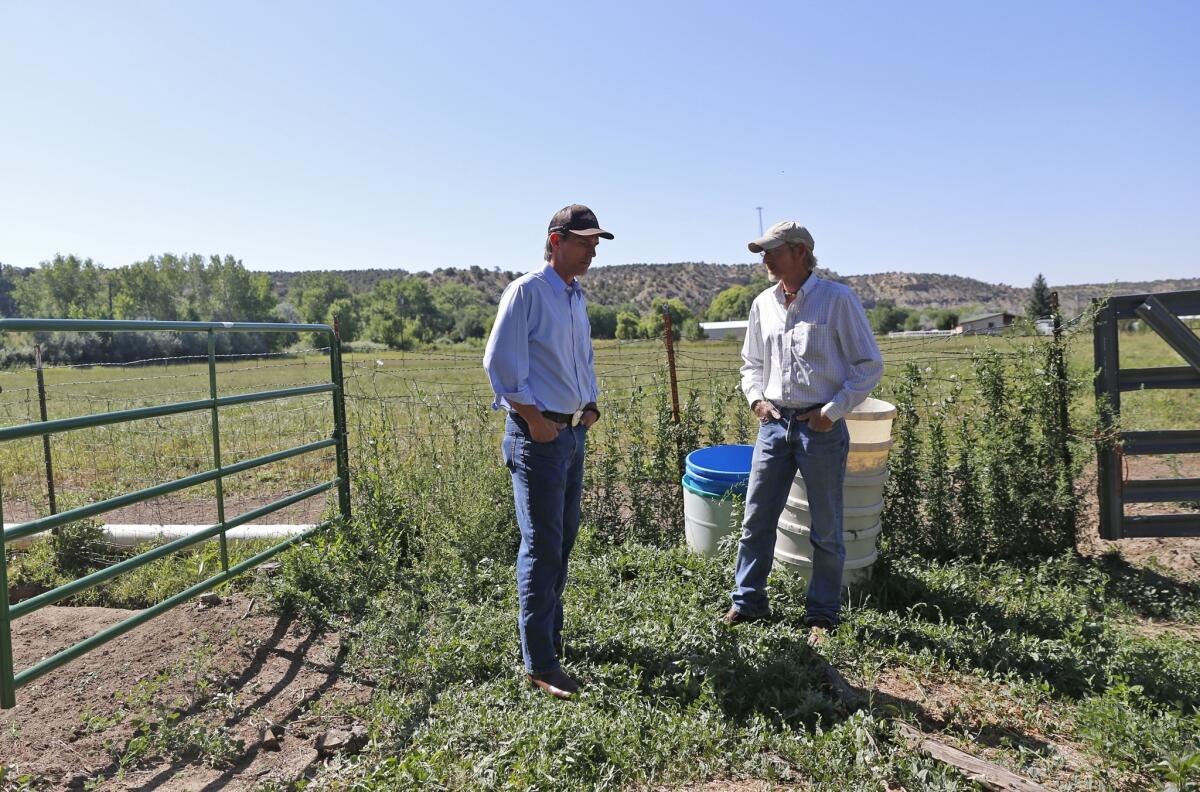Colorado’s Animas River reopens to recreation after mine wastewater spill

Rancher Jarod Ray, right, talks with U.S. Sen. Martin Heinrich (D-N.M.) at his ranch in Aztec, N.M. Heinrich joined the local fire department to deliver water to residents affected by the Gold King Mine spill that occurred in the Animas River in Colorado.
- Share via
Reporting from Silverton, Colo. — Nine days after 3 million gallons of mine waste spilled into the Animas River, Colorado officials, with the support of the U.S. Environmental Protection Agency, reopened the waterway in La Plata County to recreation and signed off on some farmers using its water for irrigation.
The river was closed off on Aug. 6, a day after toxic water poured out of the Gold King Mine near Silverton in southwest Colorado, sending a plume of water colored bright yellow from heavy metals.
The nearby town of Durango relies heavily on tourism, and kayaking outfitters and fishing guides had to tell customers the river was off-limits. The wastewater was unleashed while the EPA was working on a cleanup operation of the defunct gold mine.
The contaminated water continued south and flowed into the San Juan River in New Mexico, putting farmers and ranchers at risk.
But by Friday the water had returned to pre-incident levels, meaning the level of metals like lead and cadmium were no longer potentially toxic, said David Ostrander, area commander for the Unified EPA Area Command.
“This is a really great day we’ve been looking forward to, getting recreation use and water use back on the river,” Ostrander said in a conference call with reporters Friday afternoon.
But the news wasn’t all good.
The Colorado Department of Public Health and Environment warned people not to drink untreated water from the river, to wash their hands and clothes if they come into contact with the river and avoid areas with discolored water.
A few samples tested higher than normal for lead, silver and thallium, but the department said in a news release that the tests still showed the water was not a risk.
Farmers who grow alfalfa and wheat are permitted to resume irrigation, but those growing green leafy vegetables have been asked to wait before irrigating.
River water for livestock has also been deemed safe by the state.
“The information we have received shows that water quality levels are comparable to those prior to the spill,” Dr. Carl Heckendorf, state veterinarian for the Colorado Department of Agriculture, said in a news release.
To the south in New Mexico, state officials lifted a precautionary ban on the use of private well water in the Animas River valley, according to the Associated Press.
The state, however, is still warning residents not to draw water from the river, eat fish from it or use it for their livestock, the AP reported. New Mexico Gov. Susana Martinez announced Friday that she was forming a review team to monitor possible long-term effects of the spill on the Animas and San Juan rivers.
Twitter: @nigelduara
More to Read
Sign up for Essential California
The most important California stories and recommendations in your inbox every morning.
You may occasionally receive promotional content from the Los Angeles Times.











